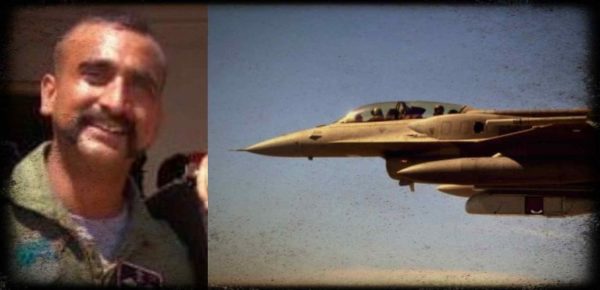In a Cold War wet dream that has at once stunned and captured the imagination of international security watchers across the world, the Indian Air Force today declared that a MiG-21 Bison fighter managed to shoot down a Pakistan Air Force F-16D on Wednesday morning over the restive Line of Control that separates Jammu & Kashmir from Pakistan-occupied Kashmir.
The MiG-21, from the Indian Air Force’s 51 Squadron ‘Sword Arms’ is said to have conducted the kill using a Russian Vympel R-73 close combat missile. The Indian Air Force today, as part of an effort to conclusively prove that it was a group of F-16 that led the sweep, produced evidence of an AIM-120 AMRAAM missile fired from the F-16, that likely brought down the MiG-21. The IAF also said it had captured electronic signatures of the aggressing aircraft, concluding that it was an F-16. While the Bison’s pilot Wing Commander Abhinandan Varthaman was captured in Pakistan-occupied Kashmir, two Pakistani pilots who punched out of the F-16D are currently unaccounted for. Pakistan has switched to claiming no loss after first announcing that it had shot down two Indian jets. The abrupt correction has led to the widespread belief that Pakistan initially believed it had shot down two Indian jets, but discovered only later that it was in fact an F-16D that had come down.
While information has been scant and buffeted by a typical hail of claims and counterclaims by both sides, Livefist has learnt from reliable sources that the unprecedented peacetime aerial confrontation yesterday — which came after a group of Indian Mirage 2000 jets flew into Pakistan a day previous to bomb a terrorist facility in the town of Balakot — was much larger than initially reported.
It is understood that at least 20 Pakistan Air Force jets, a mix of F-16s, Mirages and JF-17s got airborne from a series of air bases in Pakistan and Pakistan-occupied Kashmir, quickly turning south towards Pakistan’s Sindh. They remained in the air for over 30 minutes, possible in an act of deception. Indian airborne early warning assets in the air had picked up the movement, with bases in Srinagar and Punjab alerted. The PAF fighter package then turned north towards the Line of Control, with all but three F-16s turning west towards their airfields, but staying in the air. The 3 F-16s then began the sweep, headed straight towards the Sunderbani sector of the Line of Control. By this time two MiG-21s from Srinagar were airborne and headed straight for the intercept. Two more MiG-21s got airborne a few minutes later, followed by a pair of Mirage 2000s. A pair of Su-30 MKI jets were already in the air on a combat air patrol further south, diverted to provide cover for the intercept. The rare within visual range engagement occured over the Sunderbani sector, with both jets — and all 3 pilots — plunging into Pakistan-occupied Kashmir.
Amidst significant claims made by both sides, perhaps most significant to aviation watchers has been the nature of the close air engagement between two nuclear armed nations, and the Cold War flavour of the actual fight.
Aviation photographer, author and analyst Angad Singh says, “It’s historic, but at the same time I am not too surprised. The Bison is among the most capable of all MiG-21 variants, and I would put money on a capable pilot in a Bison cockpit any day.”
Italian journalist David Cenciotti, who runs he excellent Aviationist blog, writes, “If confirmed, it’s significant, as it would prove once again that when it deals with aerial engagement, not always does the more modern and capable weapon system (in this case the F-16 Block 52) wins. Several factors must be taken into consideration: pilot skills; support from other assets (including fighters and AEW aircraft), ground radars, etc. Above all, RoE play an essential role: if the Rules of Engagement require a positive VID of the opponent, a fighter might be forced to come WVR (Within Visual Range) where a MiG-21 can be particularly threatening. That’s why even 5th gen aircraft regularly train with legacy adversaries.”
He adds, “The MiG-21 Bison is an upgraded version of the Russian-made baseline MiG-21. Although the design is obsolete, its low radar visibility, instantaneous turn rate and acceleration, and the helmet mounted sight combined with high-off-boresight R-73 air-to-air missiles are among the factors that can make the upgraded MiG-21 a threatening adversary, even for more modern fighters.” (More from Cenciotti on Livefist here).
Veteran MiG-21 fighter pilot & author-historian Air Vice Marshal Arjun Subramaniam says, “An IAF Bison shot down an F-16 with a close combat missile the R-73 and during the pursuit crossed the LC and was brought down by ground fire. It was classic aerial action and of great significance that an F-16 was downed by an IAF Mig-21.”
Stephen Trimble, defense editor at Aviation Week tweeted, “Don’t forget those same MiG-21s embarrassed USAF F-15Cs at Cope India in 2006.” He later told Livefist, “The F-16 was designed specifically to beat the MiG-21, but AMRAAM, which came later, can be a great equalizer if basic fighter maneuvers are not involved.” (More from Trimble on Livefist here).
Air Vice Marshal Manmohan Bahadur, veteran pilot and Additional Director General of India’s Centre for Air Power Studies (CAPS) told Livefist,”For the first time, a third generation aircraft has shot down a fly by wire modern aircraft armed with a much better weapons package and avionics suite. Just goes to prove that the man behind the machine counts — and counts massively. And when it comes to the IAF, adversaries should have no doubts.”
Vishnu Som, defence editor with NDTV, says, “While we don’t know the exact circumstances in which the IAF pilot was shot down, let’s not for a moment forget that he shot down an F-16 first (possibly an F-16 Block 50) with an upgraded MiG-21 Bison, a jet which first entered service with the IAF in the sixties.”
Yusuf Unjhawala, defence columnist and editor of Indian Defence Forum, says, “That a MiG-21 shot down an F-16 is proof of its capability & our pilot training. A few years back MiG-21s won against US F-16s at Cope India.”
Mihir Shah, aviation watcher and columnist, says, “The significance of a supposedly obsolete MiG-21 shooting down a more modern F-16 cannot be understated. It goes to show that legacy systems can (and often are) upgraded to stay competitive against with their more modern counterparts. The MiG-21’s R-73 missile, cued by a helmet-mounted sight, is a formidable close-combat weapon. And it emphasizes the old adage that equipment isn’t everything—the man behind the machine matters just as much, if not more. Wing Commander Abhinandan was a well-trained, experienced pilot, and those qualities showed up in spades during this engagement.”
Independent defence analyst Dr Sanjay Badri-Maharaj says, “The significance of air combat between a MIG-21 and an F-16 cannot be understated. The fact, regardless of claims regarding the loss of an F-16, that MiG-21 fought an F16 on equal terms cannot be understated. Combat capabilities of the MiG-21 remain viable through upgrades to radars and weapons systems. The choice of the R-73 is also interesting. Were the MiGs armed with R 77s or not? If not, it is even more remarkable that the MiG-21 tackled the F-16 on any sort of even basis. However, while we get carried away with individual air combat, the fact that a combination of Pakistani aircraft was met by a combination of Indian aircraft and was unable to achieve its purported objective is perhaps the most important thing to take away from this entire episode.”






Leave a reply